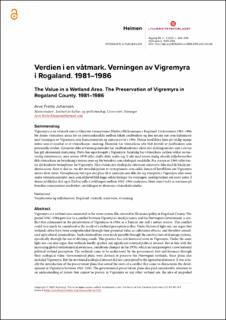Verdien i en våtmark. Verningen av Vigremyra i Rogaland. 1981–1986
Peer reviewed, Journal article
Published version
Permanent lenke
https://hdl.handle.net/11250/2788615Utgivelsesdato
2021-09Metadata
Vis full innførselSamlinger
Originalversjon
Johansen, A.F. (2021) Verdien i en våtmark. Verningen av Vigremyra i Rogaland. 1981–1986. Heimen - Lokal og regional historie, 58 (3), pp. 262-280. 10.18261/issn.1894-3195-2021-03-05Sammendrag
Vigremyra er en våtmark som er tilknyttet vannsystemet Håelva i Hå kommune i Rogaland. I tidsrommet 1981–1986 ble denne våtmarken arena for en interessekonflikt mellom lokale jordbrukere og den norske stat som kulminerte med verningen av Vigremyra som Ramsarområde og naturreservat i 1986. Denne konflikten kom på veldig mange måter som et resultat av et våtmarkssyn i endring. Historisk har våtmarkene ofte blitt forstått av jordbrukere som potensielle verdier. Gjennom ulike avvanningsmetoder har jordbruksaktører sikret nye dyrkingsarealer som i sin tur har gitt økonomisk inntjening. Dette har også foregått i Vigremyra. Samtidig har våtmarkene sjelden vekket nevneverdig statsinteresse, men utover 1970-tallet skulle dette endre seg. I takt med tiårets stadig økende miljøbevissthet fikk våtmarkene ny betydning i statens øyne og ble betraktet som økologisk verdifulle. Fra starten av 1980-tallet fantes det konkrete verneplaner for Vigremyra. Men statens nye økologiske interesser samsvarte ikke med de lokale jordinteressene. Som vi skal se, var det introduksjonen av verneplanene som sådde kimen til konflikten om Vigremyra utover dette tiåret. Verneplanene viet også stor plass til et natursyn som ikke lar seg etterprøve i Vigremyra eller noen andre våtmarksområder, men som allikevel fikk legge solide føringer for verningen, nemlig tanken om urørt natur. I denne artikkelen skal også Håelvas rolle i utviklingen mellom 1981–1986 analyseres, blant annet ved å se nærmere på hvordan vannsystemet medvirket i utviklingen av aktørenes våtmarksforståelse. Vigremyra is a wetland area connected to the water system Hå, situated in Hå municipality in Rogaland County. The period 1981–1986 gave rise to a conflict between Vigremyra’s local peasants and the Norwegian Government: a con flict that culminated in the preservation of Vigremyra in 1986, as a Ramsar site and a nature reserve. This conflict could very much be considered as the result of a wetland perception in flux. Under historical light one can argue that wetlands often have been comprehended through their potential value as cultivation objects, and therefore consid ered agricultural commodities. Such commodities were made possible through the construction of drainage systems, specifically through the use of ditching canals. This practice has rich historical roots in Vigremyra. Under the same light one can also argue that wetlands hardly sparked any significant national political interest. But in line with the increasing global environmental awareness, conditions changed in the 1970s, which in turn prompted a new national political wetland perception. The wetlands came to be understood, by the government, first and foremost through their ecological value. Governmental plans were devised to preserve the Norwegian wetlands, these plans also included Vigremyra. But the newfound ecological interest did not correspond to the agricultural interest. It was actu ally the introduction of the preservation plans that sowed the roots of a conflict that came to characterize the devel opment in Vigremyra between 1981–1982. The governmental preservation plans also paid considerable attention to an understanding of nature that cannot be proven in Vigremyra or any other wetland site, the idea of unspoiled nature. In the following we shall observe how this problematic notion got to shape important parts of the preserva tion in 1986. By analyzing how the water system collaborated in the shaping of the cultural agent’s wetland perception and interest, this article will also uncover how river Hå played a central role in the events that unfolded in Vigremyra.

